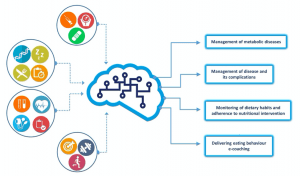Dev Kapadia ’23

Figure 1: Because of its versatility, machine learning has many applications in the field of medicine, depending on the inputs of an algorithm.
[Source: Wikimedia Commons]
Beyond the augmentation of daily life, machine learning can also help to save lives. Since its advent, there has been excitement about machine learning’s applications to medicine. Algorithms can help with drug development, diagnosis of diseases from medical images, patient care, and more. One area where machine learning has already been applied is lung cancer detection. Lung cancer continues to be the most deadly form of cancer, taking almost 150,000 lives per year in the United States, which includes the large US smoking population.2 Most of the symptoms of lung cancer only develop once the disease has advanced to more serious stages, making the treatment of the disease extremely difficult. To help solve the problem, engineering innovation company Draper recently used the power of machine learning to improve the efficacy of early detection of lung cancer. Draper’s design utilizes three-dimensional neural networks to aid in both the detection of the disease and diagnosis of malignancy (spread of the cancer to other organs outside the lungs). While current results are promising, the team at Draper claims that the accuracy of the algorithm was limited by the small dataset used for training. Further investment into more robust datasets along with the incorporation of patient referral can greatly augment the system in the future.3
However, machine learning can be pushed beyond disease detection and employed to make novel discoveries at an expedited rate. The British drug discovery company Exscientia recently developed a new drug with the help of machine learning algorithms. The Exscientia team partnered with Sumitomo Dainippon Pharma to produce the new medicine that aims to treat obsessive-compulsive disorder. The usual development of a drug takes about five years. However, this project took only twelve months to create and is already in clinical testing.4
Lastly, machine learning has been applied to blood glucose monitoring. Traditionally, glucose levels have been measured using blood samples acquired by the uncomfortable “fingerprick test.” Recent developments have been made for an implantable continuous glucose monitoring system, but this option can be too invasive for some patients.5 A research team recently published a study that suggests low blood glucose levels may be detected by analyzing electrocardiogram (ECG) readouts. The algorithm was trained on patient ECG readings and looks for unique patterns that signal abnormal glucose levels. This data can benefit diabetics and non-diabetics individuals alike, but it is especially important for those with diabetes because large fluctuations in their blood glucose levels can lead to dangerous conditions. Even more, this technology can potentially be integrated with wearable ECG reading devices to provide a minimally invasive option for many patients.6
While the previous three examples highlight some of the recent developments in machine learning applications in medicine, there are still many areas where these algorithms and others like them can be applied. The field of medicine is constantly changing to optimize patient care, and computers now play a major role in the improvement of medical practice.
Bibliography:
- 15 Ways Machine Learning Will Impact Your Everyday Life. (2019, January 25). Elite Data Science. Retrieved February 22, 2020, from https://elitedatascience.com/machine-learning-impact
- Stoddard, J. (2020, January 13). Top Five Most Dangerous Cancers in Men and Women. UnityPoint Health. Retrieved February 22, 2020, from https://www.unitypoint.org/desmoines/services-cancer-article.aspx?id=c9f17977-9947-4b66-9c0f-15076e987a5d
- Ozdemir, O., Russell, R. L., & Berlin, A. A. (2019, October 29). A 3D Probabilistic Deep Learning System for Detection and Diagnosis of Lung Cancer Using Low-Dose CT Scans. IEEE Trans Med Imaging. DOI: 10.1109/TMI.2019.2947595
- Sandle, T. (2020, February 3). Essential Science: How AI is advancing medical science. Digital Journal. Retrieved February 22, 2020, from http://www.digitaljournal.com/tech-and-science/science/essential-science-how-ai-is-advancing-medical-science/article/566360
- Commissioner, O. of the. (2018, June 21). FDA approves first continuous glucose monitoring system with a fully implantable glucose sensor and compatible mobile app for adults with diabetes. Retrieved March 2, 2020, from https://www.fda.gov/news-events/press-announcements/fda-approves-first-continuous-glucose-monitoring-system-fully-implantable-glucose-sensor-and
- Porumb, M., Stranges, S., Pescapè, A., & Pecchia, L. (2020, January 13). Precision Medicine and Artificial Intelligence: A Pilot Study on Deep Learning for Hypoglycemic Events Detection based on ECG. Sci Rep 10(170). https://doi.org/10.1038/s41598-019-56927-5.

Leave a Reply